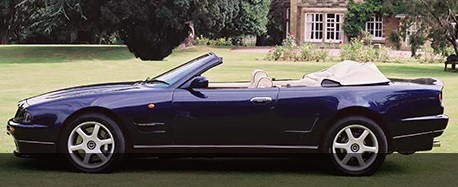

Coupe, 2 Doors, 4 Seats
557 Hp @ 6500 rpm.
104.3 Hp/l
5340 cm3
325.87 cu. in.
8, V-engine
Rear wheel drive,
4745 mm
186.81 in.
1924 mm
75.75 in.
1920 kg
4232.88 lbs.
| Brand | Aston Martin |
|---|---|
| Model | V8 Vantage (Convertible) |
| Version | V8 Vantage (II) |
| Engine version | 5.3 i V8 32V (557 Hp) |
| Year production start | 1993 |
| Year production end | 2000 |
| Vehicle type | Coupe |
| Horsepower RPM | 557 Hp @ 6500 rpm. |
| Acceleration 0 - 100 kmh sec | 4.7 sec |
| Curb weight kg -lbs total |
1920 kg4232.88 lbs. |
| Overall length mm - inch |
4745 mm186.81 in. |
| Doors | 2 |
| Cam configuration | OHC |
|---|---|
| Engine position and orientation | Front, Longitudinal |
| Cylinders | 8 |
| Position of cylinders | V-engine |
| Displacement (liters) |
5340 cm3325.87 cu. in. |
| Eng. horsepower RPM | 557 Hp @ 6500 rpm. |
| Horsepower per litre | 104.3 Hp/l |
| Weight / horsepower kg/hp - hp/tons |
3.4 kg/Hp290.1 Hp/tonne |
| Weight / torque kg/Nm - Nm/tons | 2.6 kg/Nm, 388 Nm/tonne
2.6 kg/Nm388 Nm/tonne |
| Torque Nm RPM lb-ft RPM |
745 Nm @ 4000 rpm.549.48 lb.-ft. @ 4000 rpm. |
| Bore (mm in) |
100 mm3.94 in. |
| Stroke (mm in) |
85 mm3.35 in. |
| Compression ratio | 8.2 |
| Fuel delivery system | Multi-point indirect injection |
| Fuel type | Petrol (Gasoline) |
| Valvetrain | 4 |
| Engine aspiration | Mechanical supercharging (Compressor) |
| Drive configuration | Rear wheel drive |
|---|---|
| Transmission | 6 |
| Front brakes | Ventilated discs |
|---|---|
| Rear brakes | Ventilated discs |
| Brake control | Ventilated discs |
| Anti-lock brake system | ABS (Anti-lock braking system) |
| Front suspension | Coil spring |
|---|---|
| Rear suspension | Helical spring |
| Wheels size | 285/45 ZR18 |
|---|
| Passengers seats | 4 |
|---|---|
| Trunk space min liter | cu. Ft. |
315 l11.12 cu. ft. |
| Overall length mm - inch |
4745 mm186.81 in. |
|---|---|
| Overall width mm -inch |
1924 mm75.75 in. |
| Overall height mm -inch |
1330 mm52.36 in. |
| Wheelbase mm - inch |
2610 mm102.76 in. |
| Track width front mm - inch |
1540 mm60.63 in. |
| Track width rear mm - inch |
1580 mm62.2 in. |
| Curb weight kg -lbs total |
1920 kg4232.88 lbs. |
|---|---|
| Fuel tank liters | gallons |
105 l27.74 US gal | 23.1 UK gal |
8 CYLINDER V-Engine
It's an engine with eight cylinder piston where the cylinders share a common crankshaft and are arranged in a V configuration.
What is the 8 cylinder V-engine displacement: it is in a range between 2926 cc and 8135 cc in recent model line up powertrain.
How much is the power of the 8 cylinder V-engine: the power of the 8 cylinder V-engine is in a range from 125 bhp to 1160 bhp.
Which cars use 8 cylinder V-engine: in recent years several manufactures have been used the V8 engine for 3 main applications: premium, sport cars and lightweight trucks. 8 V engine is the American preferred engine for iconic giant pick-up.
What is the eight cylinder V angle: the majority of V8 engines use a V-angle of 90 degrees. This angle results in good engine balance and low vibrations. The downside is a larger powertrain body that makes the use of this configuration suitable only for longitudinal position and rear drive wheels traction.
V8 engines with a 60 degree V-angle were used in the 1996-1999 by Ford and in 2005-2011 by Volvo. The Ford engine used a 60 degree V-angle because it was based on a V6 engine with a 60 degree V-angle. Both the Ford and Volvo engines were used in transverse engine chassis, which were designed for a front-wheel-drive layout. To reduce the vibrations caused by the unbalanced 60 degree V-angle, Volvo's used a balance shaft and offset split crankpins.
The Rolls-Royce Meteorite tank engine also used a 60 degree V-angle, since it was derived from the 60 degree V12 Rolls-Royce Meteor which in turn was based on the famous Rolls-Royce Merlin V12 engine.
Most V8 engines fitted to road cars use a cross-plane crankshaft, since this configuration produces less vibration due to the perfect primary balance and secondary balance.
The rumbling exhaust sound produced by a typical cross-plane V8 engine is partly due to the uneven firing order within each of the two banks of four cylinders and with separate exhaust systems for each bank of cylinders, this uneven pulsing creates the legendary rumbling sound that is typically of V8 engines.
edited by arrabbiata